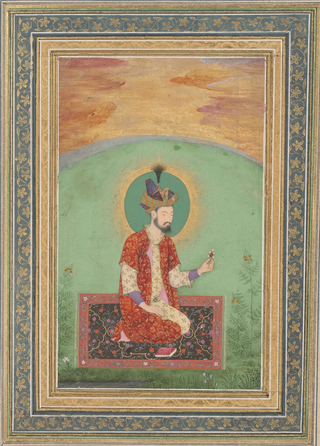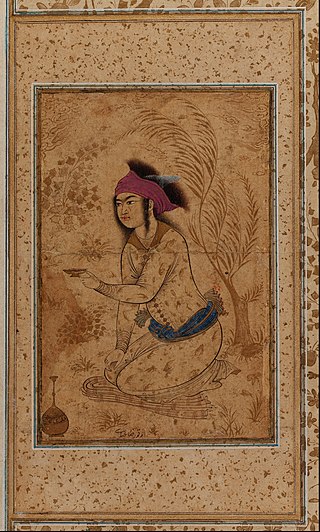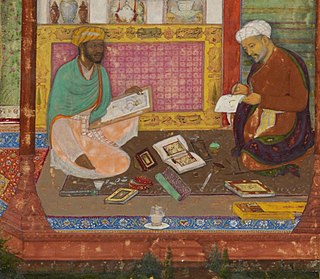

Dust Muhammad (or Doust Muhammad) was a Persian painter of miniatures, calligrapher, and art historian, active from about 1510 to 1564. Later in life he worked in India.


Dust Muhammad (or Doust Muhammad) was a Persian painter of miniatures, calligrapher, and art historian, active from about 1510 to 1564. Later in life he worked in India.
Dust Muhammad was born in Herat in the late 15th century, although the date is not known. He was a disciple of Kamāl ud-Dīn Behzād, working with teachers in Herat. Prince Bahram Mirza first spotted his talent and invited him to work in his studio. By early 1520 Muhammad moved with Behzad from Herat to Tabriz. After the death of Shah Ismail I, he remained in the service of Shah Tahmasp I, taking part in the illustration of the famous Shahnameh of Shah Tahmasp, however his contribution is much more modest than that of Sultan Mohammed or Mir Musavvir.
After the death of Behzad, Muhammad left the Tahmasp court. According to some researchers, he was a nomad and he could no longer sit in the same spot. In the late 1530s he worked at the court of the ruler of Kabul, Kamran Mirza, brother of the Mughal emperor Humayun.
In 1555, and at the invitation of the Emperor, he traveled to India. By about 1550 he had created a miniature on a separate sheet, created by order of the Mughal emperor - "The Emperor Humayun and his brothers in a landscape". The interior of this piece is styled Turkmen Sultan Muhammad. Much of it takes the form of grotesque mountain elephants and other animals (especially loved by Shah Tahmasp). The emperor Humayun sits on a stone throne, and in the distance under the trees play three boys, one of whom is the future Emperor Akbar I.
In the early 1560s, the court of the Mughal emperors was already under Emperor Akbar I, and Dust Muhammad left India and returned to Iran. He lived out the last days in Qazvin. The exact date of his death is unknown.
Dust Muhammad learned the art of calligraphy from a master Shadishaha Qasim, a student of the famous calligrapher of Herat Sultan Ali Mashhadi. From the pen of Muhammad came out excellent artistic calligraphic manuscripts and samples. Some of them are presented in the Russian National Library in St. Petersburg. For a long time Muhammad was the head of the Safavid royal court of Prince Bahram Mirza, a famous patron of the arts, but also the master of calligraphy, artist, musician and poet. Muhammad also worked for his brother Bahram Mirza - Shah Tahmasp I, and enjoyed the title of "Royal calligrapher".
Dust Muhammad in the first chapter is known as the author of an essay on Persian painting. In the years 1544–45. He wrote a treatise on calligraphers and artists. This work is extant in the muraqqa of calligraphic designs and miniatures, known as the "Album of Bahram Mirza", which is stored in the library of the Topkapı Palace Museum in Istanbul.
The first nineteen sheets album as a preface is a treatise Dust Muhammad, written by beautiful handwriting, probably belonging to the author. In addition to the Treaty on the album are three more works Dust Muhammad - two miniatures with the caption "Master Dust" and calligraphic passage, signed "Douste-Muhammad Musavvir" (the artist).
Treatise written in the Persian language, includes an introduction to the origin of the letter, the head of the masters of handwriting "taʿliq" and "nastaʿlīq", a section on the history of art and its masters, and especially - the information about the court artists and calligraphers of Bahram Mirza. Despite the confusion of mythical and historical names, the history of painting the picture painted by Dust Muhammad is of considerable interest. His writing provides a clear allusion to the existence of a religious ban images of living beings, and at the same time on the relativity of this prohibition. In his treatise Muhammad does not touch any problems the art of painting, nor any of its equipment. The value of this work lies in the extensive knowledge of the life and work of Persian artists of the 14th to 16th centuries.

Nasir al-Din Muhammad, commonly known by his regnal name Humayun, was the second Mughal emperor, who ruled over territory in what is now Eastern Afghanistan, Bangladesh, Northern India, and Pakistan from 1530 to 1540 and again from 1555 to his death 1556. At the time of his death the Mughal Empire spanned almost one million square kilometres.

Tahmasp I was the second shah of Safavid Iran from 1524 until his death in 1576. He was the eldest son of Ismail I and his principal consort, Tajlu Khanum. Ascending the throne after the death of his father on 23 May 1524, the first years of Tahmasp's reign were marked by civil wars between the Qizilbash leaders until 1532, when he asserted his authority and began an absolute monarchy. He soon faced a long-lasting war with the Ottoman Empire, which was divided into three phases. The Ottoman sultan, Suleiman the Magnificent, tried to install his own candidates on the Safavid throne. The war ended with the Peace of Amasya in 1555, with the Ottomans gaining sovereignty over Iraq, much of Kurdistan, and western Georgia. Tahmasp also had conflicts with the Uzbeks of Bukhara over Khorasan, with them repeatedly raiding Herat. In 1528, at the age of fourteen, he defeated the Uzbeks in the Battle of Jam by using artillery.

Kamāl ud-Dīn Behzād, also known as Kamal al-din Bihzad or Kamaleddin Behzād, was a Persian painter and head of the royal ateliers in Herat and Tabriz during the late Timurid and early Safavid Periods. He is regarded as marking the highpoint of the great tradition of Islamic miniature painting. He was well known for his very prominent role as kitābdār in the Herat Academy as well as his position in the Royal Library in the city of Herat. His art is unique in that it includes the common geometric attributes of Persian painting, while also inserting his own style, such as vast empty spaces to which the subject of the painting dances around. His art includes masterful use of value and individuality of character, with one of his most famous pieces being "The Seduction of Yusuf" from Sa'di's Bustan of 1488. Behzād's fame and renown in his lifetime inspired many during, and after, his life to copy his style and works due to the wide praise they received. Due to the great number of copies and difficulty with tracing origin of works, there is a large amount of contemporary work into proper attribution.

Mughal painting is a South Asian style of painting on paper confined to miniatures either as book illustrations or as single works to be kept in albums (muraqqa), originating from the territory of the Mughal Empire in the Indian subcontinent. It emerged from Persian miniature painting and developed in the court of the Mughal Empire of the 16th to 18th centuries. Battles, legendary stories, hunting scenes, wildlife, royal life, mythology, as well as other subjects have all been frequently depicted in paintings.

A Persian miniature is a small Persian painting on paper, whether a book illustration or a separate work of art intended to be kept in an album of such works called a muraqqa. The techniques are broadly comparable to the Western Medieval and Byzantine traditions of miniatures in illuminated manuscripts. Although there is an equally well-established Persian tradition of wall-painting, the survival rate and state of preservation of miniatures is better, and miniatures are much the best-known form of Persian painting in the West, and many of the most important examples are in Western, or Turkish, museums. Miniature painting became a significant genre in Persian art in the 13th century, receiving Chinese influence after the Mongol conquests, and the highest point in the tradition was reached in the 15th and 16th centuries. The tradition continued, under some Western influence, after this, and has many modern exponents. The Persian miniature was the dominant influence on other Islamic miniature traditions, principally the Ottoman miniature in Turkey, and the Mughal miniature in the Indian sub-continent.

'Abd al-Ṣamad or Khwaja 'Abd-us-Ṣamad was a 16th century painter of Persian miniatures who moved to India and became one of the founding masters of the Mughal miniature tradition, and later the holder of a number of senior administrative roles. 'Abd's career under the Mughals, from about 1550 to 1595, is relatively well documented, and a number of paintings are authorised to him from this period. From about 1572 he headed the imperial workshop of the Emperor Akbar and "it was under his guidance that Mughal style came to maturity". It has recently been contended by a leading specialist, Barbara Brend, that Samad is the same person as Mirza Ali, a Persian artist whose documented career seems to end at the same time as Abd al-Samad appears working for the Mughals.

Safavid art is the art of the Iranian Safavid dynasty from 1501 to 1722, encompassing Iran and parts of the Caucasus and Central Asia. It was a high point for Persian miniatures, architecture and also included ceramics, metal, glass, and gardens. The arts of the Safavid period show a far more unitary development than in any other period of Iranian art. The Safavid Empire was one of the most significant ruling dynasties of Iran. They ruled one of the greatest Persian empires since the Muslim conquest of Persia, and with this, the empire produced numerous artistic accomplishments.

A Muraqqa is an album in book form containing Islamic miniature paintings and specimens of Islamic calligraphy, normally from several different sources, and perhaps other matter. The album was popular among collectors in the Islamic world, and by the later 16th century became the predominant format for miniature painting in the Persian Safavid, Mughal and Ottoman empires, greatly affecting the direction taken by the painting traditions of the Persian miniature, Ottoman miniature and Mughal miniature. The album largely replaced the full-scale illustrated manuscript of classics of Persian poetry, which had been the typical vehicle for the finest miniature painters up to that time. The great cost and delay of commissioning a top-quality example of such a work essentially restricted them to the ruler and a handful of other great figures, who usually had to maintain a whole workshop of calligraphers, artists and other craftsmen, with a librarian to manage the whole process.

The illuminated manuscript Khamsa of Nizami British Library, Or. 12208 is a lavishly illustrated manuscript of the Khamsa or "five poems" of Nizami Ganjavi, a 12th-century Persian poet, which was created for the Mughal Emperor Akbar in the early 1590s by a number of artists and a single scribe working at the Mughal court, very probably in Akbar's new capital of Lahore in North India, now in Pakistan. Apart from the fine calligraphy of the Persian text, the manuscript is celebrated for over forty Mughal miniatures of the highest quality throughout the text; five of these are detached from the main manuscript and are in the Walters Art Museum, Baltimore as Walters Art Museum MS W.613. The manuscript has been described as "one of the finest examples of the Indo-Muslim arts of the book", and "one of the most perfect of the de luxe type of manuscripts made for Akbar".

The Khamsa or Panj Ganj is the main and best known work of Nizami Ganjavi.

Prince Ibrahim Mirza, Solṭān Ebrāhīm Mīrzā, in full Abu'l Fat'h Sultan Ibrahim Mirza was a Persian prince of the Safavid dynasty, who was a favourite of his uncle and father-in-law Shah Tahmasp I, but who was executed by Tahmasp's successor, the Shah Ismail II. Ibrahim is now mainly remembered as a patron of the arts, especially the Persian miniature. Although most of his library and art collection was apparently destroyed by his wife after his murder, surviving works commissioned by him include the manuscript of the Haft Awrang of the poet Jami which is now in the Freer Gallery of Art in Washington D.C.
Persian people were one of the major ethnic groups, who accompanied the ethnic Turco-Mongol ruling elite of the Mughal Empire after its invasion of the Indian subcontinent. Throughout the Mughal Empire, a number of ethnic Persian technocrats, bureaucrats, traders, scientists, architects, teachers, poets, artists, theologians and Sufis migrated and settled in different parts of the Indian Subcontinent.

Aqa Mirak was a Persian illustrator and painter.

Mir Musavvir was a Persian painter at the Safavid court at Tabriz and later the Mughal court at Kabul. During his time at the royal Safavid workshop, he contributed to the Shahnameh of Shah Tahmasp. He was the father of Mir Sayyid Ali, who adopted his occupation of painting.

Mir Sayyid Ali was a Persian miniature painter who was a leading artist of Persian miniatures before working under the Mughal dynasty in India, where he became one of the artists responsible for developing the style of Mughal painting, under Emperor Akbar.

Mir Ali Heravi, also known as Mir Ali Hossein Heravi and Mir Jan, titled as Kateb-e Soltani, was a prominent Persian calligrapher and calligraphy teacher of Nastaʿlīq script in the 16th century. He was the second significant Persian calligrapher after Mir Emad. He had artistic influence on the later calligraphers.

The Shahnameh of Shah Tahmasp or Houghton Shahnameh is one of the most famous illustrated manuscripts of the Shahnameh, the national epic of Greater Iran, and a high point in the art of the Persian miniature. It is probably the most fully illustrated manuscript of the text ever produced. When created, the manuscript contained 759 pages, 258 of which were miniatures. These miniatures were hand-painted by the artists of the royal workshop in Tabriz under rulers Shah Ismail I and Shah Tahmasp I. Upon its completion, the Shahnameh was gifted to Ottoman Sultan Selim II in 1568. The page size is about 48 x 32 cm, and the text written in Nastaʿlīq script of the highest quality. The manuscript was broken up in the 1970s and pages are now in a number of different collections around the world.

Sultan Muhammad was a Persian painter at the Safavid court at Tabriz under Shah Ismail I and Shah Tahmasp I. He served as the director of Shah Ismail's artists’ workshop and as the first project director of the Shahnameh of Shah Tahmasp. He gave painting lessons to Tahmasp when he was the crown prince.
Bahram Mirza Safavi was a Safavid prince, governor and military commander in 16th-century Iran. He was the youngest son of Shah Ismail I, the founder of the Safavid dynasty.

Farangi-Sazi was a style of Persian painting that originated in Safavid Iran in the second half of the 17th century. This style of painting emerged during the reign of Shah Abbas II, but first became prominent under Shah Solayman I.